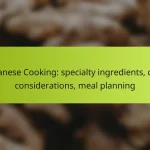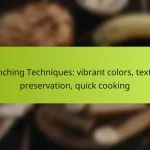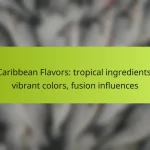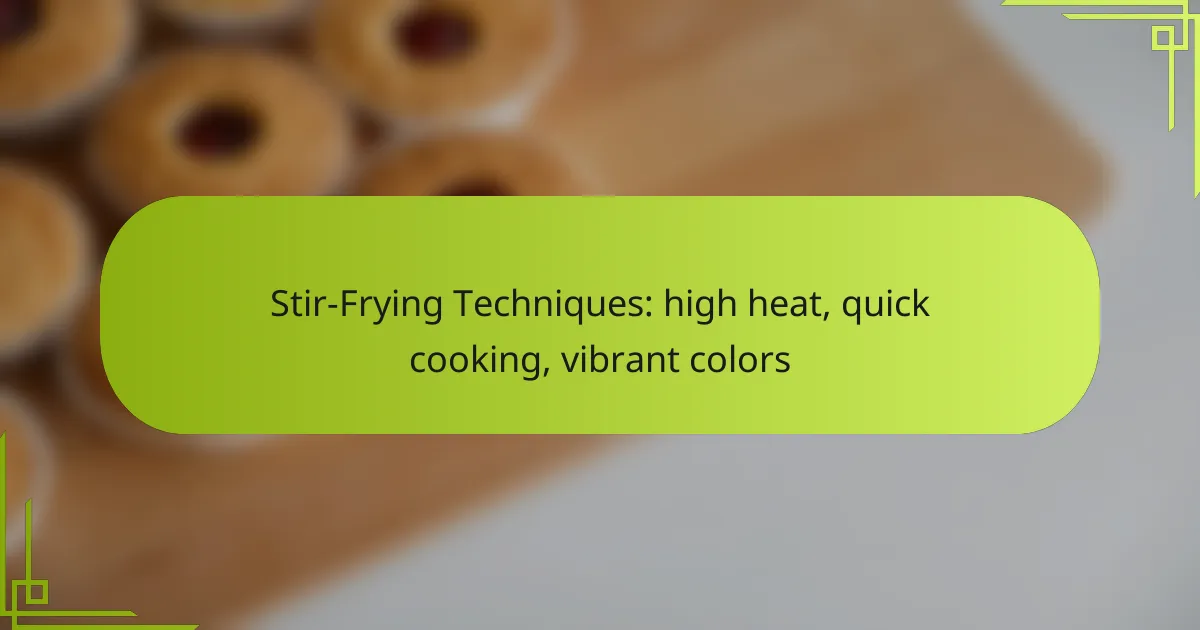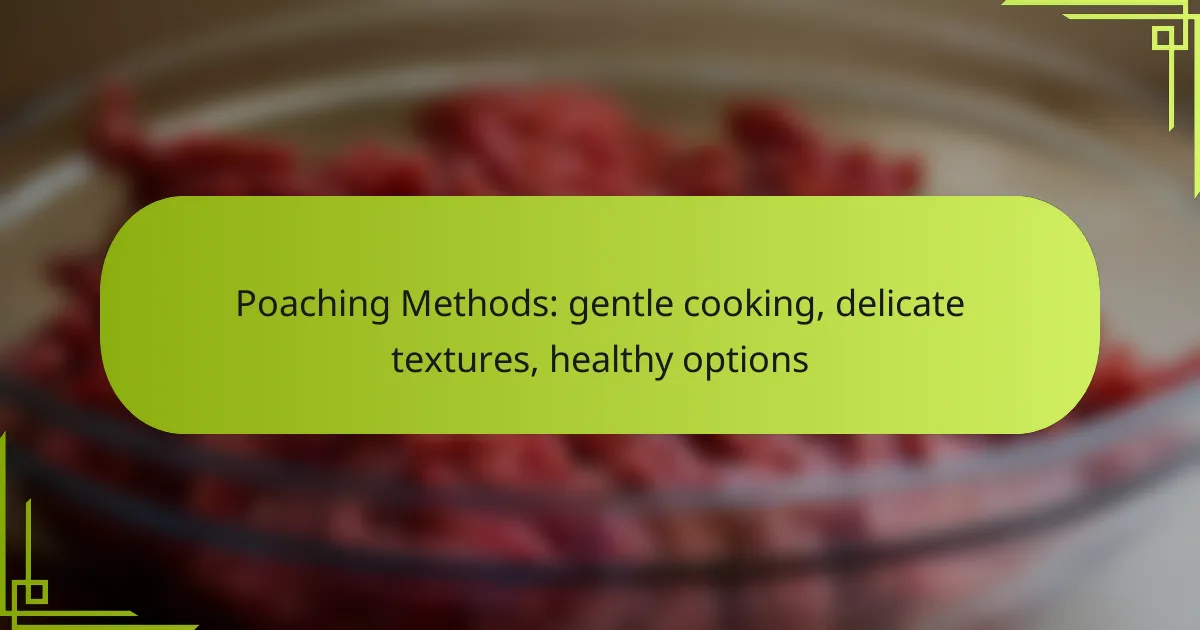Baking is an art that hinges on precise measurements, which ensure consistent results and optimal texture in every creation. By understanding texture variations, bakers can manipulate ingredients and techniques to achieve their desired outcomes, from airy cakes to dense brownies. Additionally, creative presentations play a vital role in enhancing the visual appeal of baked goods, making them not only delicious but also memorable for those who indulge.
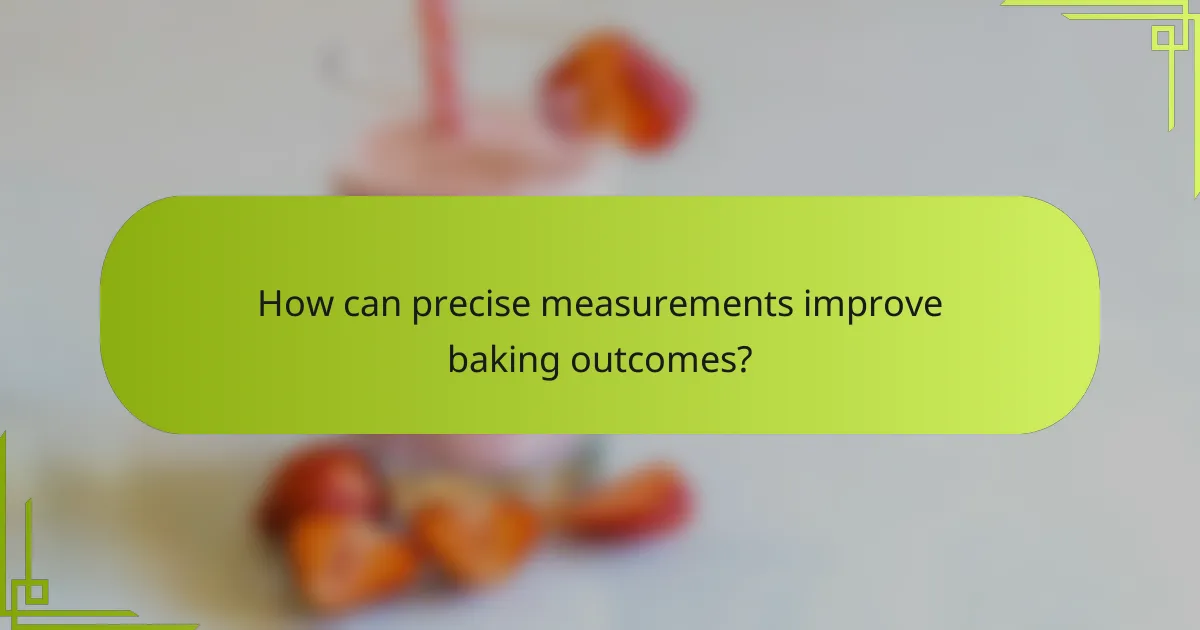
How can precise measurements improve baking outcomes?
Precise measurements are crucial in baking as they ensure consistent results and optimal texture. Accurate quantities of ingredients can significantly affect the final product, influencing everything from rise to flavor balance.
Importance of accurate weighing
Accurate weighing is essential because baking is a science that relies on chemical reactions. Even slight variations in ingredient amounts can lead to undesired results, such as dense cakes or overly dry cookies. For example, too much flour can absorb moisture, resulting in a dry texture.
Using a scale to measure ingredients rather than relying on volume can enhance precision. This is particularly important for ingredients like flour and sugar, which can vary in density based on how they are packed.
Using digital scales for consistency
Digital scales provide a reliable way to achieve consistent measurements every time you bake. They allow for quick adjustments and can measure in various units, such as grams or ounces, catering to different recipes. This versatility helps in following international recipes that may use different measurement systems.
When using a digital scale, always zero out the weight of the container before adding ingredients. This ensures that only the ingredient weight is measured, leading to more accurate results.
Common measurement conversions
Understanding common measurement conversions is vital for successful baking, especially when adapting recipes. For instance, 1 cup of all-purpose flour typically weighs around 120 grams, while 1 cup of granulated sugar weighs about 200 grams. Knowing these conversions can help when scaling recipes up or down.
Here’s a quick reference for some common conversions:
- 1 cup all-purpose flour = 120 grams
- 1 cup granulated sugar = 200 grams
- 1 cup brown sugar (packed) = 220 grams
- 1 cup butter = 227 grams
Utilizing these conversions can simplify the baking process and improve accuracy, leading to better outcomes in your baked goods.
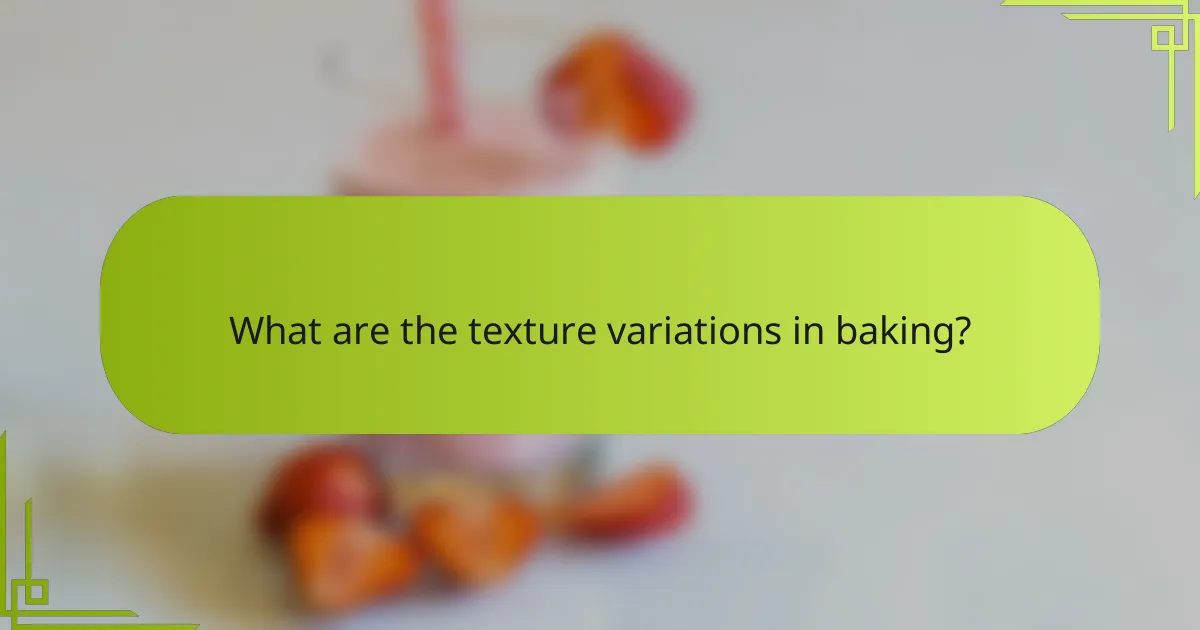
What are the texture variations in baking?
Texture variations in baking refer to the different mouthfeel and structural qualities that baked goods can exhibit, influenced by ingredients and techniques. Understanding these variations helps bakers achieve desired results, whether they aim for a light and airy cake or a dense and moist brownie.
Understanding crumb structure
Crumb structure describes the internal texture of baked goods, which can range from fine and uniform to coarse and irregular. A fine crumb, often found in cakes, is achieved through thorough mixing and the right balance of ingredients, while a coarser crumb may result from less mixing or higher flour content. The size and distribution of air pockets within the crumb also significantly affect the final texture.
To assess crumb structure, consider the visual appearance and tactile feel of the baked item. A well-developed crumb should be light and springy, indicating proper leavening and mixing techniques were employed.
Effects of ingredient ratios on texture
The ratios of key ingredients like flour, sugar, fat, and liquid play a crucial role in determining texture. For example, increasing fat content typically leads to a richer, denser texture, while higher flour ratios can create a drier product. Adjusting sugar levels can also affect moisture retention and tenderness.
When experimenting with ingredient ratios, start with small adjustments. For instance, reducing flour by about 10-15% can yield a moister cake, while increasing sugar can enhance browning and crispness. Always keep notes on changes to replicate successful outcomes.
Examples of texture variations in cakes
Cakes can exhibit a wide range of textures, from light and fluffy to dense and fudgy. For example, a chiffon cake is known for its airy texture, achieved by incorporating whipped egg whites, whereas a pound cake is denser due to its high butter and sugar content. Understanding these differences allows bakers to choose the right recipe for their desired outcome.
Other examples include sponge cakes, which are light and porous, and flourless chocolate cakes, which are rich and moist. Each type requires specific techniques and ingredient ratios to achieve the intended texture, making it essential to follow recipes closely or adjust based on experience.
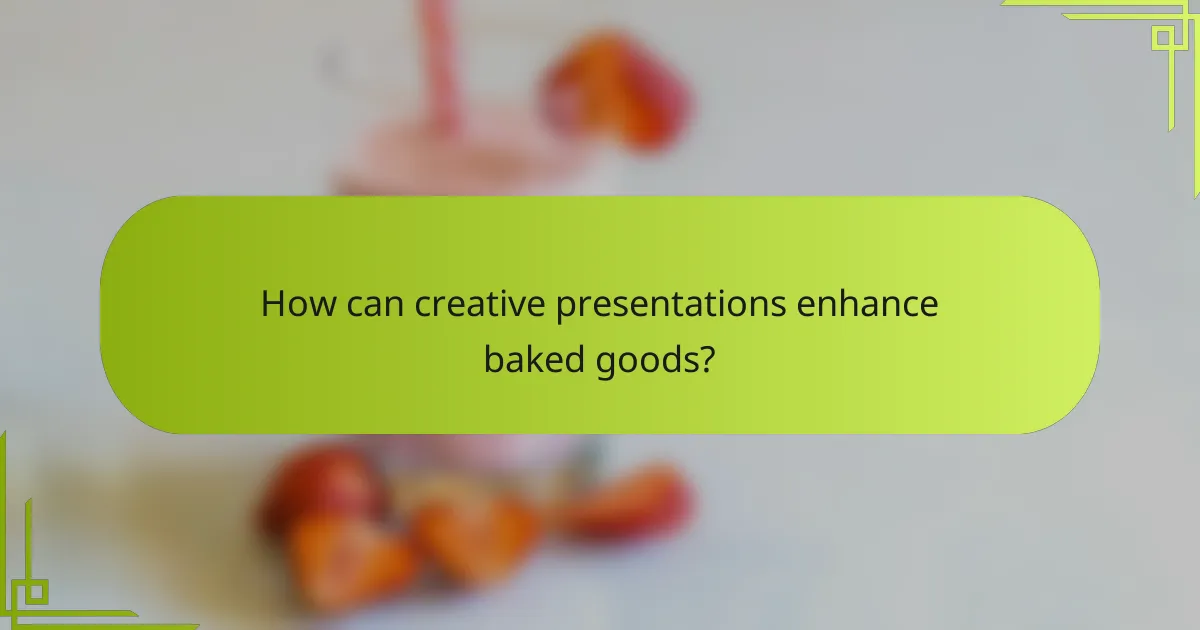
How can creative presentations enhance baked goods?
Creative presentations can significantly elevate the appeal of baked goods by making them visually enticing and memorable. A well-presented item not only attracts attention but also enhances the overall dining experience, encouraging people to indulge in the treat.
Decorative techniques for cakes
Decorative techniques for cakes include methods such as fondant covering, buttercream piping, and edible embellishments. Using fondant allows for smooth finishes and intricate designs, while buttercream can be shaped into flowers or patterns. Consider incorporating seasonal themes or color palettes to align with occasions, enhancing the cake’s visual impact.
When decorating, balance is key. Too many elements can overwhelm the design, so focus on a few standout features. For example, a simple cake can be transformed with a single, elegant flower or a striking color contrast.
Plating styles for pastries
Plating styles for pastries involve arranging baked items in a way that highlights their textures and flavors. Use clean, contrasting plates to make the pastries pop. Consider layering items or using height to create visual interest, such as stacking croissants or arranging tarts in a fan shape.
Incorporate negative space on the plate to draw attention to the pastries. A sprinkle of powdered sugar or a drizzle of sauce can add a finishing touch that enhances both flavor and presentation.
Using garnishes for visual appeal
Using garnishes can significantly boost the visual appeal of baked goods. Fresh fruits, edible flowers, or chocolate shavings can add color and texture. For instance, a slice of cake topped with berries not only looks vibrant but also adds a fresh flavor contrast.
When selecting garnishes, ensure they complement the main item. Avoid overly complex garnishes that may distract from the baked good itself. Simple, well-chosen garnishes can elevate the overall presentation without overwhelming the viewer.

What are the best tools for precise baking measurements?
For precise baking measurements, the best tools include digital kitchen scales, measuring cups, and measuring spoons. These tools ensure accuracy in ingredient quantities, which is crucial for achieving the desired texture and flavor in baked goods.
Recommended kitchen scales
Digital kitchen scales are essential for precise baking measurements, as they provide accurate weight readings in grams or ounces. Look for models that can measure in small increments, ideally down to 1 gram, to ensure precision for ingredients like flour or sugar.
When choosing a scale, consider features such as a tare function, which allows you to subtract the weight of containers, and a clear display for easy reading. Brands like Ozeri and Escali offer reliable options that are popular among home bakers.
Essential measuring cups and spoons
Measuring cups and spoons are vital for liquid and dry ingredient measurements. Use a set of dry measuring cups for ingredients like flour and sugar, and liquid measuring cups for liquids such as water or milk. Ensure that these tools are marked clearly for easy reading.
For dry ingredients, a standard set typically includes 1 cup, 1/2 cup, 1/3 cup, and 1/4 cup, while liquid measuring cups often come in 1 cup, 2 cup, and 4 cup sizes. Stainless steel or glass options are durable and easy to clean, making them a practical choice for frequent bakers.
Digital thermometers for accuracy
Digital thermometers are crucial for ensuring that baked goods are cooked to the correct internal temperature. They provide quick and accurate readings, which can help prevent undercooking or overcooking. Look for models with a probe that can easily be inserted into various baked items.
For most baked goods, an internal temperature of around 190-210°F (88-99°C) is ideal. A good digital thermometer should have a fast response time and a clear display. Brands like ThermoWorks and Taylor offer reliable options that are favored by both professional and home bakers.
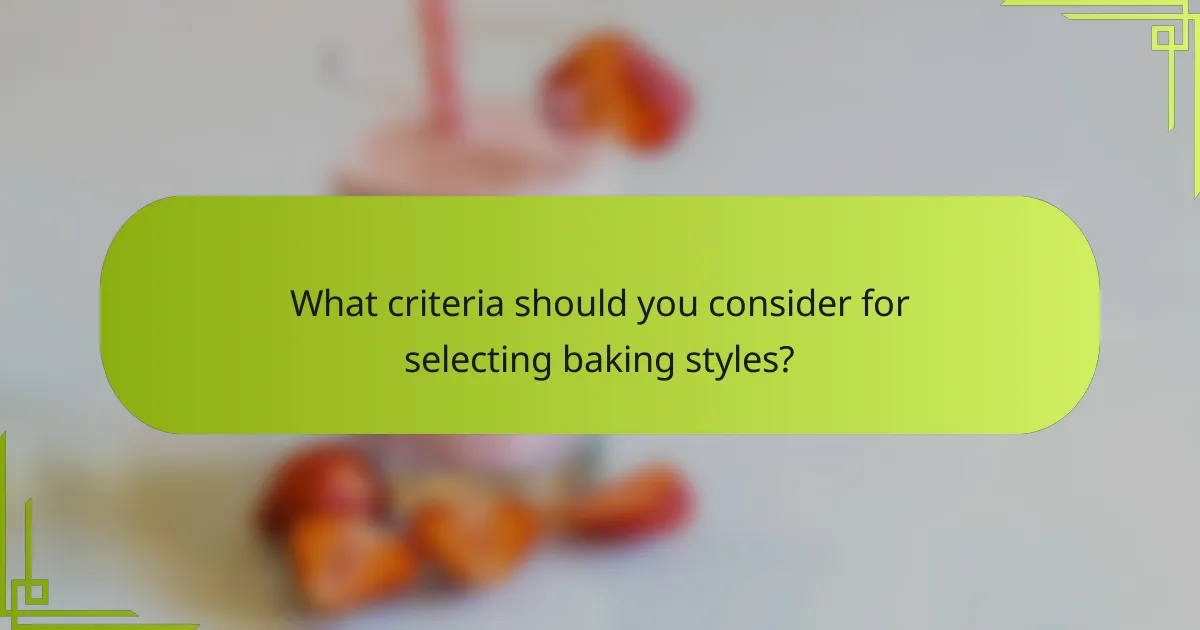
What criteria should you consider for selecting baking styles?
When selecting baking styles, consider factors such as audience preferences, ingredient availability, and the required baking time and temperature. These criteria will help you choose a style that not only meets your goals but also resonates with those who will enjoy the final product.
Assessing audience preferences
Understanding your audience’s preferences is crucial in selecting a baking style. Consider factors like dietary restrictions, flavor profiles, and presentation styles that appeal to your target group. For example, if your audience prefers healthier options, you might opt for whole grain or gluten-free recipes.
Additionally, think about the occasion. A casual gathering may call for simple, rustic baked goods, while a formal event might require elegant, intricately designed desserts. Tailoring your baking style to fit the audience enhances their overall experience.
Evaluating ingredient availability
Ingredient availability can significantly influence your choice of baking style. Assess what ingredients are easily accessible in your area, as this will determine the feasibility of certain recipes. For instance, if specialty items are hard to find, you may need to adapt recipes to use more common ingredients.
Consider seasonal ingredients as well. Utilizing fruits and vegetables that are in season can enhance flavor and reduce costs. Always keep a well-stocked pantry with essential baking staples like flour, sugar, and baking powder to ensure flexibility in your baking endeavors.
Understanding baking time and temperature
Baking time and temperature are critical factors that can affect the final outcome of your baked goods. Different styles require varying temperatures; for example, delicate pastries often need lower temperatures to prevent burning, while bread may require higher heat for proper crust formation. Familiarize yourself with standard baking temperatures, typically ranging from 160°C to 220°C (320°F to 425°F), depending on the recipe.
Timing is equally important. Overbaking can lead to dry textures, while underbaking may result in gooey centers. Use a timer and check for doneness with methods like toothpick tests or visual cues to ensure your baked goods achieve the desired texture and flavor.


